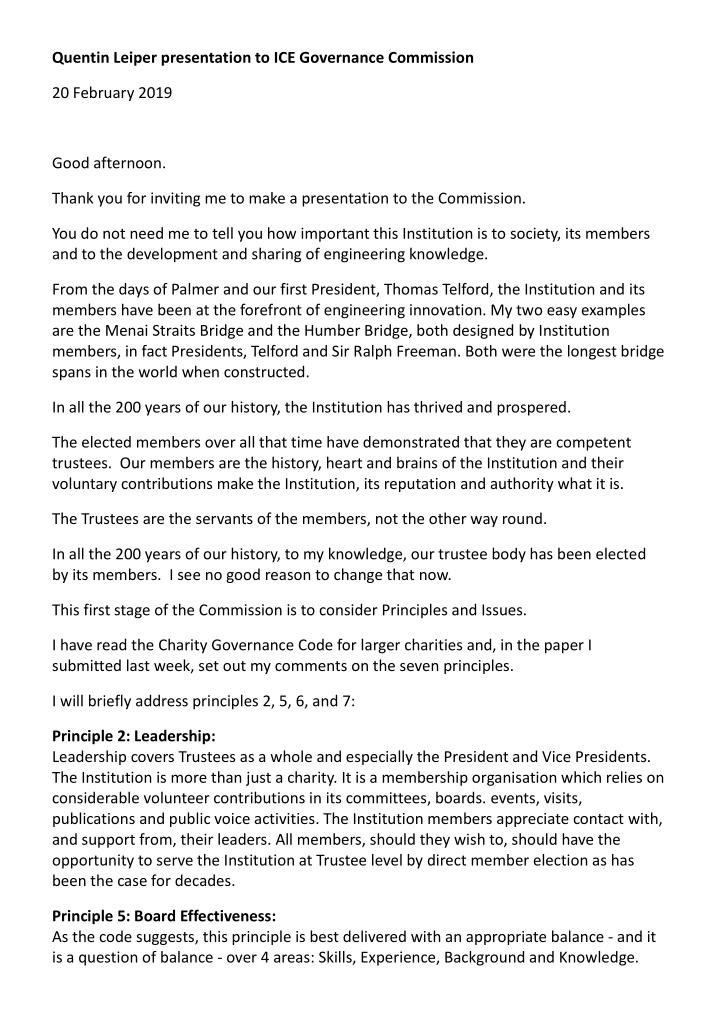



Quentin Leiper presentation to ICE Governance Commission 20 February 2019 Good afternoon. Thank you for inviting me to make a presentation to the Commission. You do not need me to tell you how important this Institution is to society, its members and to the development and sharing of engineering knowledge. From the days of Palmer and our first President, Thomas Telford, the Institution and its members have been at the forefront of engineering innovation. My two easy examples are the Menai Straits Bridge and the Humber Bridge, both designed by Institution members, in fact Presidents, Telford and Sir Ralph Freeman. Both were the longest bridge spans in the world when constructed. In all the 200 years of our history, the Institution has thrived and prospered. The elected members over all that time have demonstrated that they are competent trustees. Our members are the history, heart and brains of the Institution and their voluntary contributions make the Institution, its reputation and authority what it is. The Trustees are the servants of the members, not the other way round. In all the 200 years of our history, to my knowledge, our trustee body has been elected by its members. I see no good reason to change that now. This first stage of the Commission is to consider Principles and Issues. I have read the Charity Governance Code for larger charities and, in the paper I submitted last week, set out my comments on the seven principles. I will briefly address principles 2, 5, 6, and 7: Principle 2: Leadership: Leadership covers Trustees as a whole and especially the President and Vice Presidents. The Institution is more than just a charity. It is a membership organisation which relies on considerable volunteer contributions in its committees, boards. events, visits, publications and public voice activities. The Institution members appreciate contact with, and support from, their leaders. All members, should they wish to, should have the opportunity to serve the Institution at Trustee level by direct member election as has been the case for decades. Principle 5: Board Effectiveness: As the code suggests, this principle is best delivered with an appropriate balance - and it is a question of balance - over 4 areas: Skills, Experience, Background and Knowledge.
I suggest that this also means Institution Experience, Background and Knowledge, particularly for the President and Vice Presidents. I believe that, as our Institution history has shown us, a larger Trustee body provides an appropriate balance of directly elected members who satisfy these criteria. Agility has been raised as a problem and one of the key reasons for a reduction in Trustee numbers. Agility has never been a problem in all my Institution experience. I believe that problems with agility can be solved with better planning and communication. Meetings can be held over the web, Skype or telephone conference call as evidenced by my own recent experience as a Pension Trustee, when meetings were held weekly and even daily as the company approached its demise. Challenge is another word which worries me. The lack of challenge within a Trustee body which is 75% nominated and only 25% elected - and the 25% have to go through a 2 stage process, providing further opportunity to weed out those who might be inclined to challenge the senior team. Principle 6: Diversity: Diversity includes members from different “constituencies” in the organisation: International, Technician and Graduate members for example. The universities model provides a balance across ages and roles. The Institution should provide a balance across membership grades, member locations and ages. Principle 7: Openness and Accountability: I do not believe that this has been a problem in the past. This principle is one which seems to have been ignored during the governance review and change process in 2016/7. The Commission might wish to consider how best to advise the new Trustee Board on this matter. My views on developing options for future ICE governance are as follows: Principles and issues: 1. The Principle that the President should engage fully and directly with the members as a key element of the President Trustee role (i.e. a 3 to 5 days a week commitment). 2. The Principle that every member elected as a Vice President or President should clearly have demonstrated a significant contribution to the Institution before being considered for such a prestigious and important role. 3. The Principle that there should be a balance of Trustees representation across membership grades and their location
4. The Principle that Trustees are directly elected by members to the Trustee Board (i.e. not via a Council). 5. The Principle that the President and Vice Presidents comprise no more than 25% of the Trustees. Options for future governance: 1. I recommend 23 Trustees: President, 4 Vice Presidents, 4 International, 6 UK Regions, 7 Fellows or Members (minimum of 3 Fellows), 1 G&S. 2. I recommend a maximum of 4 Vice Presidents on the Trustee Board. There might be one additional (light duties) VP who is not a Trustee. 3. I recommend that the Regions (including International) and Regional Chairs Committee fulfil the role of “a consultative council”. 4. I recommend that the number of members required to call an SGM remain at 60. 5. I recommend the 5 Principles I have described above. I commend these principles and recommendations to the Commission.
Recommend
More recommend